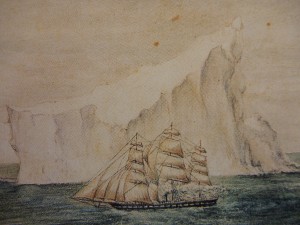14 The Challenger Expedition (1872-76)
For many years scientists believed that the deep oceans were “lightless and lifeless,” but between 1868 and 1870 dredging off the Scottish coast disproved this belief, and the science of oceanography was born. The first voyage to explore the possibilities of the fledgling science was effectively a joint venture between the Royal Navy and the Royal Society. HMS Challenger sailed from Sheerness, Scotland, under the command of George Strong Nares (1831–1915) on 7 December 1872, and returned more than three years later, on 24 May 1876, with such a wealth of scientific data that it took from 1885 to 1895 to compile it into 50 volumes containing some 30,000 pages of information that would take decades to analyze.
The goals of the expedition were global and ambitious. Among other tasks, it was to “investigate the physical conditions of the Deep Sea, in the great Ocean basins … in regard to Depth, Temperature, Circulation, Specific Gravity, and Penetration of Light.” Challenger, a military corvette with a displacement of 2,352 tonnes, had been adapted for survey and scientific purposes, and carried six civilian scientists as well as 20 officers and 200 crew. The southward voyage was remarkably slow as they established the painstaking and time-consuming procedures for scientific dredging and sampling. On 16 February 1874, Challenger became the first steamship to cross the Antarctic Circle, and it went on to reach 66º40´S at 78º30´E. The much-quoted steam-powered vessel claim is rather misleading, since the greater part of the voyage, both within and beyond the Antarctic Circle, was conducted under sail. Sublieutenant Lord George Campbell wrote that steam was used only “in a prolonged calm when, if we had coal to spare, we steamed slowly on our way.” Challenger was not ice-strengthened; even using a combination of sail and screw, she barely survived her brief time among the icebergs.
Nevertheless, whether powered by its 1,200-horsepower engine or the 16,000 square feet of sails on its three masts, Challenger completed a remarkable scientific voyage. She sailed across the Atlantic to Brazil and then returned eastwards, calling at the Tristan da Cunha and Iles Kerguelen, and at Heard Island. The men saw their first iceberg only days after leaving Iles Kerguelen, and many more soon followed. Challenger remained in the ice for less than three weeks before continuing onwards to Melbourne, and then to Japan and the North Pacific. She did not go back to the Southern Ocean, but returned home by way of Tahiti, Chile, the Strait of Magellan, and Montevideo.
Chief scientist Professor Wyville Thomson later reported that Challenger had made 362 observation stations during the voyage, “at intervals as nearly uniform as possible.” Although the expedition’s sojourn in the south was so short, it contributed greatly to Antarctic science, including establishing that there was a permanent cell of high atmospheric pressure over Antarctica. Earlier expeditions into the southern ice had observed rocks and debris trapped in icebergs drifting northward, but it was left to Challenger to dredge the floor of the Southern Ocean for the rocks released from these melting icebergs. The rocks she laboriously hauled to the surface with her 18-horsepower winch were quite different from the rocks of the sub-Antarctic islands, providing clear evidence of the existence of a distinct Southern Continent. South of 43ºS, her dredging haul included about 400 animal species, more than 80 percent of which had never been seen before.
When Challenger steamed into Portsmouth in May 1876, she had covered 127,600 kilometers (68,890 nautical miles). Captain Nares was no longer on board, having been recalled from Hong Kong to lead the British Arctic Expedition of 1875–76 into the Canadian Arctic. But while Nares was seeking the North Pole and discovering the Challenger Mountains, Challenger’s scientists and crew methodically continued their scientific work. They took daily magnetic observations while at sea. They collected flora, fauna, and geological samples on a range of sub-Antarctic islands, and acquired a wealth of information about ocean currents and temperatures, meteorology, and the seafloor of the basins of the Pacific, Atlantic, and Southern oceans. It had been a long, slow voyage because the scientific program required the ship to stop for most of a day every 320 kilometers (200 miles) to dredge and conduct soundings—but it was extremely productive, and provided information that is of value to this day.
author: David McGonigal
Thinking of travelling to Antarctica?
Visit our Antarctic travel guide.
Early Explorers
- 01 First speculations
- 02 The Age of Exploration
- 03 Ferdinand Magellan
- 04 Sir Francis Drake
- 05a James Cook (1768-1771)
- 05b James Cook (1772-75)
- 05c James Cook The Final Voyage
- 06 Thaddeus von Bellingshausen (1819-21)
- 07 Who first saw Antarctica?
- 08 Who first set foot on Antarctica?
- 09 James Weddell (1822-24)
- 10 Sealers and whalers
- 10a Biscoe and the Enderby Brothers
- 11 Jules Sébastien César Dumont d’Urville (1837-40)
- 12 Charles Wilkes (1838-42)
- 13 James Clark Ross (1839-43)
- 14 The Challenger Expedition (1872-76)
- 15 Adrien de Gerlache (1897-1899)
- 15 Henryk Johan Bull (1894-95)
- 16 Carsten Borchgrevink (1898-1900)





 Email Newsletter
Email Newsletter